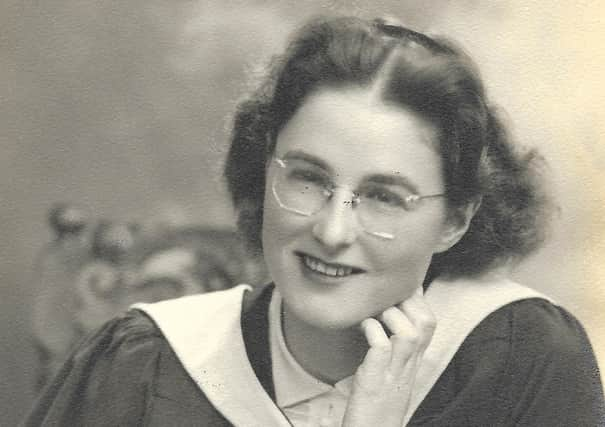Obituary: Ailsa Maxwell, historian and Enigma codebreaker, who witnessed Nazi surrender message


Ailsa Maxwell was an unsuspecting Edinburgh University student when she was invited to an interview at the Foreign Office for a mysterious job.
She had just completed the first year of an economics degree with distinction and had intended to join the Wrens when she was summoned in the summer of 1943.
Advertisement
Hide AdAdvertisement
Hide AdThey could not divulge what or where the job was but told the 20-year-old it was important work for which she was considered suitable.
She accepted and less than two years later found herself witness to the one of the most momentous events of the Second World War – the German surrender.
Her appointment had been to the top secret British codebreaking establishment, Bletchley Park, known as Station X, in Buckinghamshire, where she worked in the machine room of Hut 6 helping to crack the German Enigma code.
The encryption changed on a daily basis, resulting in an enormously complicated operation to decipher it and the vital messages being transmitted by the enemy. Maths genius Alan Turing developed Bombe machines, improved by fellow codebreaker Gordon Welchman, to decrypt Engima’s secret settings. They were the forerunners of today’s computers and Maxwell’s role was to compile bombe menus from “cribs” – clues to guess what the settings of the machine could be – and to check their output.
“Our main job was, when a stop from the Bombes satisfied the way it had been set up, we then set this up on the Enigma machines to see whether it was right,” she explained in an interview for the Bletchley Park Oral History project.
“We didn’t know German but it was quite obvious whether what came out was nonsense or made sense... I enjoyed it when we made up programmes, it was fun and something unusual to do.”
Maxwell worked alongside Asa, later Lord, Briggs, who became a renowned social historian, and both were on overnight duty when the unconditional surrender message from Hitler’s successor, Grand Admiral Dönitz, was received early on May 7, 1945, in clear, uncoded text.
Like everyone at Bletchley, she had been required to sign the Official Secrets Act and kept that vow of silence on her work for more than 30 years. The codebreakers’ operation was declassified in the mid 1970s but she admitted: “It took a bit longer for me to talk about it.”
Advertisement
Hide AdAdvertisement
Hide AdMore than 70 years later she saw the 2014 film The Imitation Game and observed it was a reasonably accurate portrayal of the Bletchley story.
Born in Gourock, to railway manager Douglas Macdonald and his wife Grace, a teacher, Ailsa Maxwell moved to London when her father’s work took him to Euston. There she was schooled at Mill Hill but her mother died when she was 14 and the teenager completed her education back in Scotland, at Dumfries Academy.
She assumed the Foreign Office must have got her name from Edinburgh University and, having agreed to the post, she had just two weeks’ training for Bletchley. Although she learned she and her colleagues were breaking codes, such was the secrecy that she never discovered their outcome.
Billeted with a young family a few miles from HQ, she regularly visited her father in London and often returned to see family in Scotland: “They just accepted that they would not be told what I was doing for a job: everyone had secrets!”
She left Bletchley almost immediately after VE Day, in May 1945, returning to Scotland to help with the general election and to finish her degree. She was working as a research assistant at the Department of Health for Scotland when she married her husband Stuart Maxwell, deputy keeper at Edinburgh’s National Museum of Antiquities of Scotland, in 1953.
The couple had two sons and when her children were older she worked, as a researcher in Edinburgh University’s economic history department, on a 10-year project leading to the publication of Michael Flinn’s Scottish Population History from the 17th Century to the 1930s. The pioneering study of demographic history won the Saltire Society’s Agnes Mure Mackenzie prize.
Later, she continued working in the capital’s Register House and, with her husband, undertook research into the history of Scottish silversmiths and goldsmiths, helping him prepare for the Society of Antiquaries of Scotland’s renowned Rhind lectures in 1975, when he presented a groundbreaking series of papers on Scottish silver. They also collaborated on transcribing the diary of George Home from Berwickshire, published as An Album of Scottish Families 1694-96, by Helen and Keith Kelsall in 1990.
The couple lived in Edinburgh’s prestigious Dick Place for 65 years, during which time she helped to establish the Samaritans service in the capital, volunteering for many years and taking on overnight telephone shifts.
Advertisement
Hide AdAdvertisement
Hide AdMrs Maxwell, whose wartime achievements are commemorated on Bletchley’s Codebreakers’ Wall, was resolutely modest about her time at the Government’s Code and Cypher School, which had once been the world’s best kept secret.
Predeceased by her husband, she spent her last 18 months in a care home in Portobello, and is survived by her sons Ian and Sandy and granddaughters Anna and Rowan.
ALISON SHAW